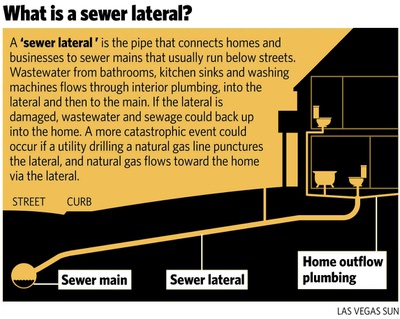Sunday, March 29, 2009 | 2 a.m.
Enlargeable graphic
Sun Archives
- Hearing ordered on gas leak at Vegas intersection (2-25-2009)
- A spark away from catastrophe (2-24-09)
- Gas leak forces evacuation of day care center (1-8-2009)
Beyond the Sun
This story starts at your toilet, and the piece of pipe that connects it and the rest of your home’s plumbing system to the sewer main under the street.
It ends with two possibilities:
• Crews putting in a new gas line run it into and break the sewer pipe — known as a sewer lateral — but don’t know they did so.
The first sign is when your toilet clogs. You call the Roto-Rooter man. His equipment goes into the pipe to clear it and breaks the gas line where it breached the lateral.
No one knows that until gas leaks into your house and it explodes.
• Or, to prevent that from happening, you end up with a heftier sewer bill to pay for local sewer operators across Nevada to spend more than $100 million to mark the location of each sewer lateral.
The 700,000 pipes buried under Nevada, carrying our waste away from businesses and homes, have quietly emerged as a major issue this legislative session.
To find and mark every sewer lateral in Southern Nevada alone would cost $100 million over five years, said Fred Schmidt, lawyer for the Southern Nevada sewer operators. The process often involves running a large camera through a sewer main, and then running a separate smaller camera up sewer laterals.
The question is: Who pays?
Schmidt says the cost should be borne by the gas and other utilities, which are pushing the regulation.
Utility companies believe the responsibility lies with the sewer operators — essentially local governments. The utilities note that local governments failed to require homebuilders to mark the lines during construction.
The problem of broken sewer laterals has arisen with the advent of technology that saves utility companies millions of dollars.
The long-standing method of laying down gas, electric, phone and other underground lines has been “trenching.” Utility company contractors tore up a street, dug a long trench and laid down the lines. If contractors broke a sewer lateral, they could see it, repair it and move on.
Over the past decade, however, a new technology has emerged. By using “directional boring,” utilities can drill down at one end of a street, then drill horizontally below the ground. The process is faster, cheaper and does not tear up roads.
But contractors can no longer see if they have breached a sewer lateral. Days, weeks or even years later, toilets can block up. And out comes the Roto-Rooter man.
Utility companies and the Public Utilities Commission say the issue is urgent. No explosions have occurred in Nevada, but 16 have happened across the nation in the past 10 years, utility company representatives testified at the Legislature this month.
“We’re extremely lucky” no houses have exploded in Nevada, said Dave Noble, a hearing officer with the PUC. Noble said Southwest Gas contractors have been proactive, using cameras to check whether sewer laterals have been broken when they lay down gas lines.
But Schmidt, the lawyer for sewer operators, says the safety issue is a “red herring to scare legislators into believing something needs to be done immediately.”
Utility companies and the Public Utilities Commission pushed a bill two years ago to give the commission authority to regulate sewer laterals.
Sewer operators protested. The bill was withdrawn.
The Public Utilities Commission in the fall passed a temporary regulation requiring sewer operators to mark sewer laterals.
Sewer operators protested again, saying it would cost too much money to buy the special equipment required to carry out the task.
In December, weeks before the regulation was to take effect, the interim Legislative Commission stepped in and ordered the PUC withdraw the order.
The Public Utilities Commission’s position comes down to this: Local governments should have always required developers to mark sewer laterals.
Noble, of the PUC, was skeptical of the estimate by sewer operators that the cost of finding and marking sewer laterals would be $100 million over five years. “I have not seen any evidence to support those numbers,” he said.
Sewer operators concede that they are the logical entity to mark the location of sewer laterals, if the step becomes necessary. But they believe the responsibility lies with the utilities because it is their new technology that creates the risk.
“The real safety issue with sewer laterals began in the last decade with directional boring,” Schmidt said. “If the safety issue becomes the dominant issue at the Legislature, local governments could temporarily prohibit or ban directional boring.”
Sewer operators offered what they see as a compromise bill. They would find and record the location of sewer laterals. But in exchange, utility company contractors would pay the cost, up to $200 for each lateral the sewer operator has to locate.
“Local governments feel it is grossly unfair to make them pay for a change in the system because technology of directional boring is preferred by utilities and contracting companies,” Schmidt said.
Utility companies and the local governments are in negotiations. The bill is expected to be heard again on Wednesday.
Utility companies, including Southwest Gas, declined to comment on the record for this story, citing the negotiations.


Join the Discussion:
Check this out for a full explanation of our conversion to the LiveFyre commenting system and instructions on how to sign up for an account.
Full comments policy